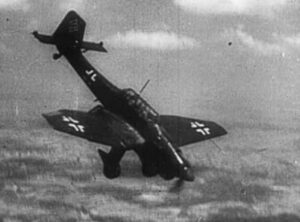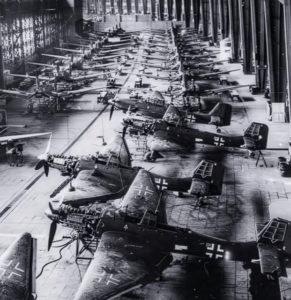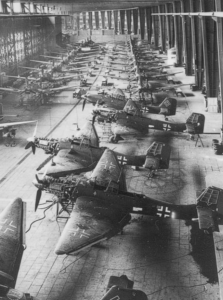During World War II, the German Luftwaffe relied heavily on the Junkers Ju 87 “Stuka” dive bomber, a symbol of precision aerial assault. In 1943, at the height of the war, the Weser-Flugzeugbau factory at Tempelhof Airport in Berlin became a key production site for these formidable aircraft. This article delves into the historical significance, manufacturing process, and impact of the Stuka assembly line during this critical period.
The Role of the Junkers Ju 87 in World War II
The Ju 87 “Stuka” was one of the most feared aircraft of the war, known for its terrifying sirens—nicknamed “Jericho Trumpets”—that struck fear into enemy troops. Designed as a precision dive bomber, the Stuka played a crucial role in the early German Blitzkrieg campaigns, excelling in ground support and tactical strikes.

By 1943, however, as Germany faced increasing resistance from the Allied forces, the need for rapid aircraft production became more pressing than ever. This led to intensified efforts at major aviation manufacturing plants, including the Weser-Flugzeugbau facility at Tempelhof.
The Weser-Flugzeugbau Factory: A Wartime Aviation Hub
Tempelhof Airport, located in Berlin, was one of Germany’s most important aviation sites before and during World War II. The Weser-Flugzeugbau factory, housed within the airport’s complex, was dedicated to the production and assembly of military aircraft, particularly the Ju 87 Stuka.
The factory operated under strict wartime conditions, with round-the-clock shifts to meet the Luftwaffe’s demands. Skilled workers, including engineers, machinists, and assembly line laborers, worked in a highly structured environment to ensure efficient aircraft production. However, as the war dragged on, forced laborers and prisoners of war were also utilized in the manufacturing process.

The Assembly Line Process of the Ju 87 Stuka
The production of the Junkers Ju 87 at Weser-Flugzeugbau followed an industrialized assembly line approach, similar to that used in automobile manufacturing. This method allowed for mass production while maintaining quality and consistency. The process involved several key stages:
1. Fabrication of Components
Raw materials such as aluminum, steel, and composite alloys were delivered to the factory for processing. Specialized machinery was used to shape and form essential components, including the aircraft’s fuselage, wings, and landing gear.

2. Engine and Cockpit Assembly
The Ju 87 was powered by the Junkers Jumo 211 engine, which was meticulously assembled and tested before installation. The cockpit, featuring an enclosed canopy and seating for both the pilot and rear gunner, was fitted with instrumentation and control mechanisms.
3. Wing and Fuselage Integration
Once individual components were completed, they were transported along the assembly line for integration. Workers carefully attached the wings, reinforced the fuselage, and installed structural reinforcements to ensure the aircraft’s durability.
4. Painting and Markings
The Ju 87s produced at Tempelhof were painted in camouflage patterns suitable for various combat environments. Luftwaffe insignia, unit markings, and identification numbers were applied before the aircraft underwent final inspections.
5. Final Testing and Deployment
Each completed Stuka underwent rigorous quality control checks and test flights before being delivered to frontline airfields. Any defects were addressed before the aircraft was deemed combat-ready.
The Challenges and Decline of Stuka Production
As the war progressed, Germany’s aviation industry faced mounting challenges. Allied bombing raids targeted key industrial centers, including Berlin, severely disrupting production at facilities like Weser-Flugzeugbau. Additionally, the Ju 87, once a dominant force in the early years of the war, became increasingly vulnerable to more advanced enemy fighters and anti-aircraft defenses.

By late 1944, production of the Ju 87 significantly declined in favor of more advanced aircraft, such as the Focke-Wulf Fw 190 and the Messerschmitt Bf 109. Nevertheless, the legacy of the Stuka and its role in the war remains a testament to Germany’s wartime aviation efforts.
Conclusion: A Glimpse into Wartime Aviation Manufacturing
The assembly line of the Junkers Ju 87 Stuka at the Weser-Flugzeugbau factory in Tempelhof represents a crucial chapter in World War II aviation history. Despite the challenges faced by Germany’s wartime production efforts, the Stuka remained a defining aircraft of the conflict, remembered for its impact on early Blitzkrieg campaigns and its role in shaping aerial warfare strategies.
Today, remnants of Tempelhof Airport serve as a reminder of Berlin’s aviation past, while surviving Stukas in museums worldwide offer insight into the engineering and legacy of this infamous dive bomber.

